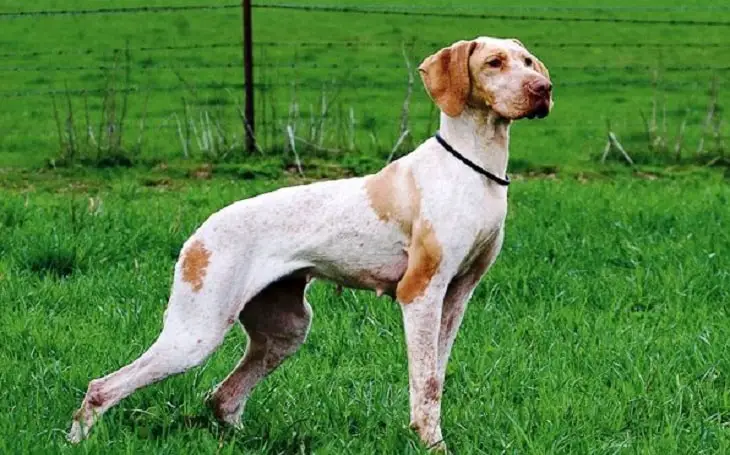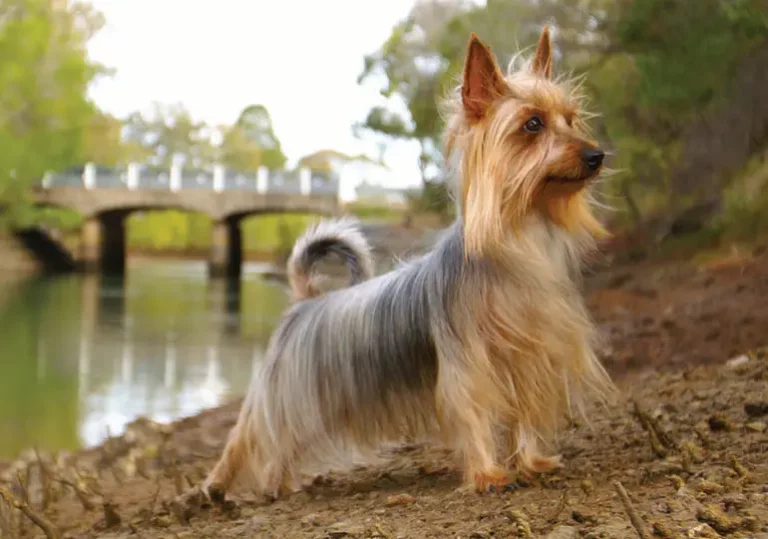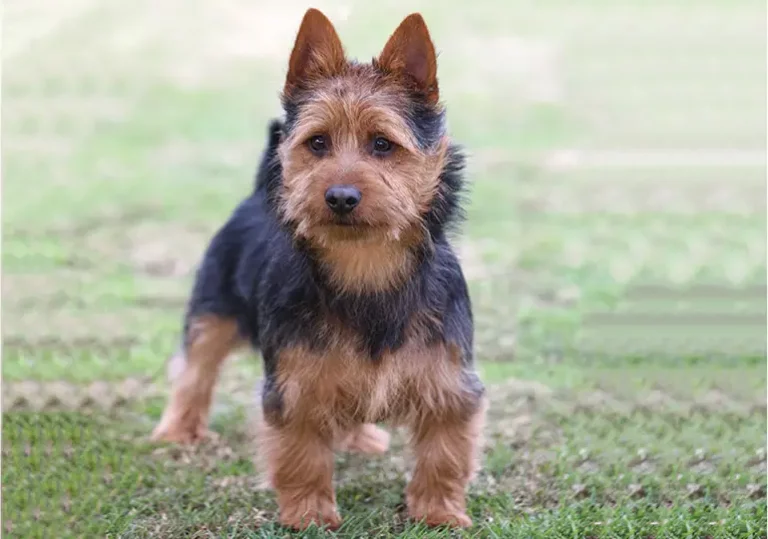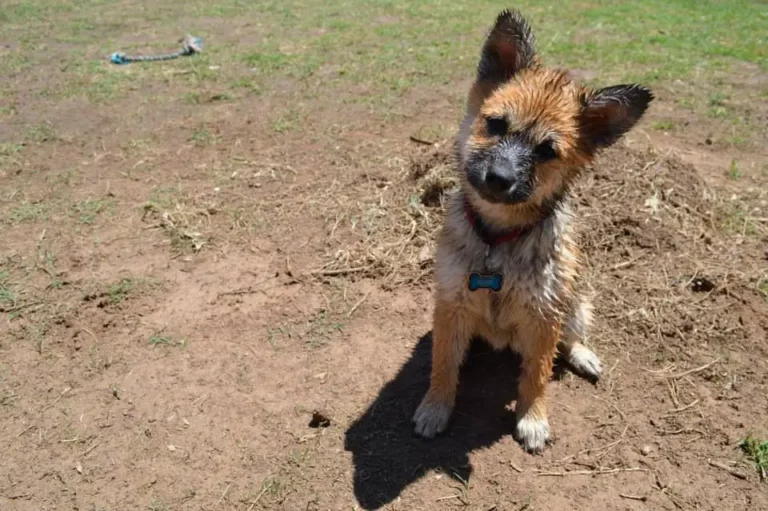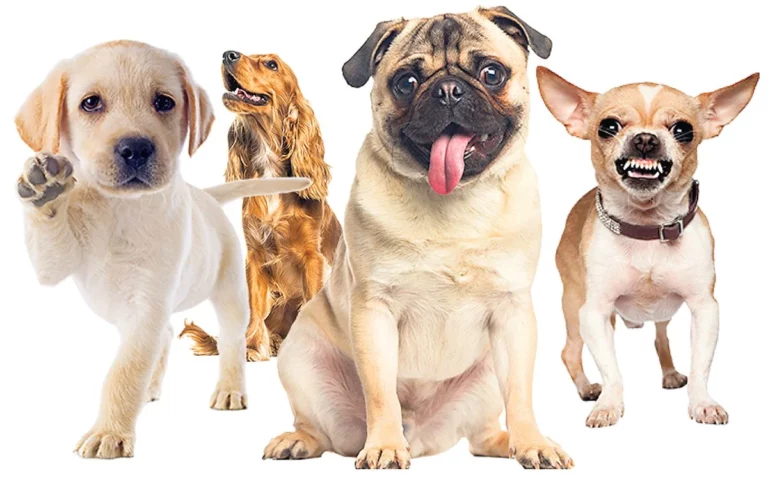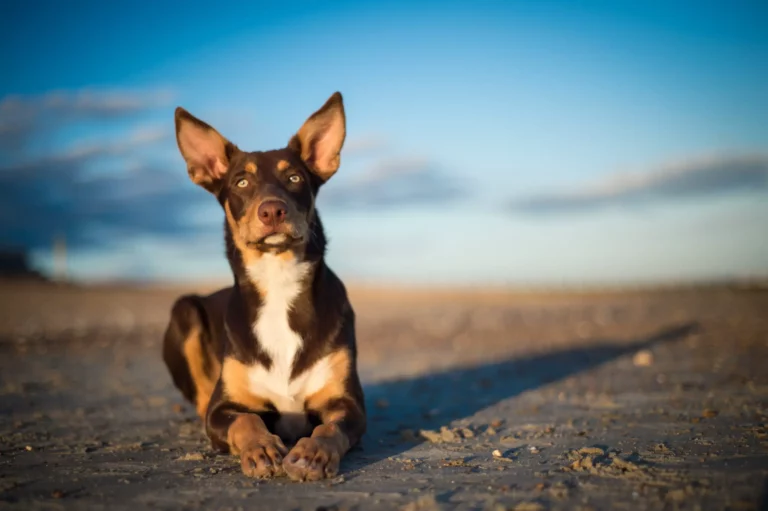Everything You Need to Know About the Australian Cattle Dog!
Owning an Australian Cattle Dog can be a rewarding and enriching experience.
These loyal and active dogs require training, socialization, exercise, grooming and specialized care in order to live happy and healthy lives.
In this guide, you’ll learn all the ins and outs of owning an Aussie Cattle dog and how to provide him with the best care possible.
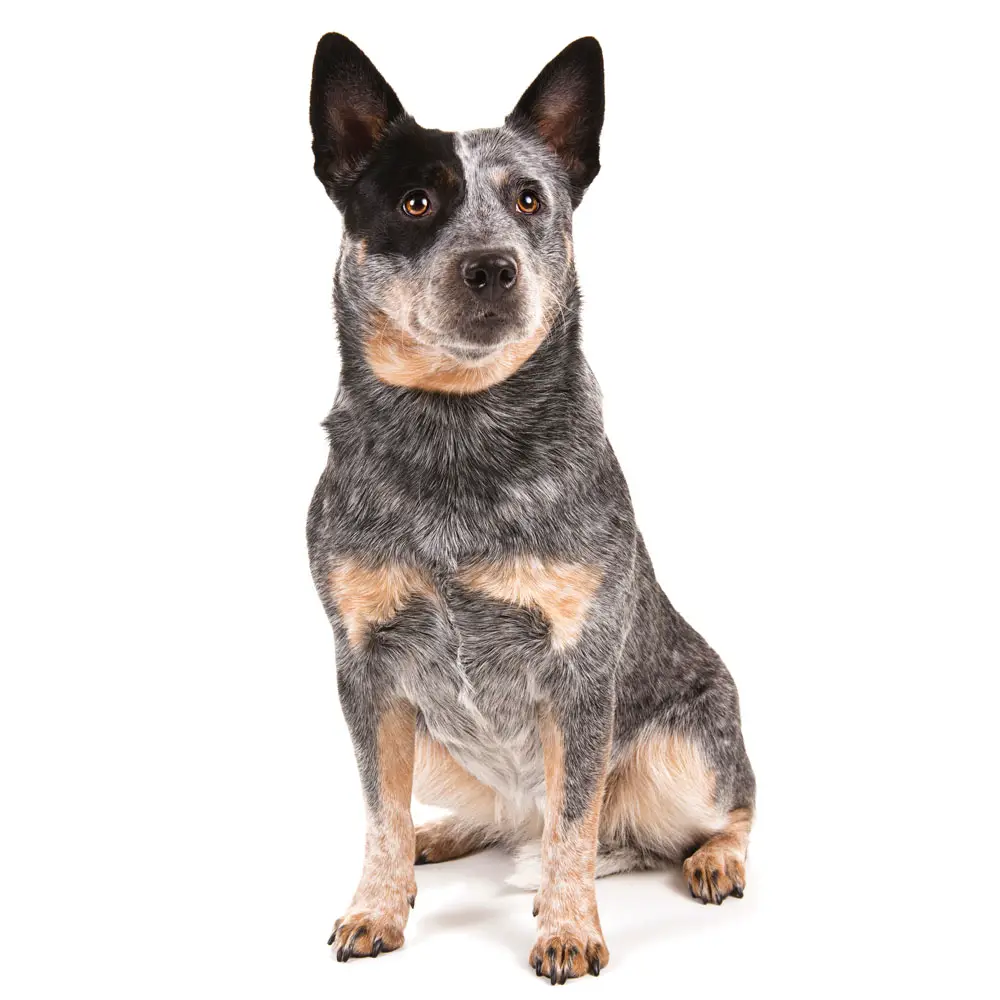
Overview of the Australian Cattle Dog
| UTILISATION | Cattle dog |
| FCI-CLASSIFICATION | Sheep and cattle dogs |
| BREED GROUP | Herding |
| COUNTRY OF ORIGIN | Australia |
| HEIGHT | Male: 46–51 cm, Female: 43–48 cm |
| WEIGHT | Male: 15–16 kg, Female: 14–16 kg |
| LIFE EXPECTANCY | 13-15 years |
| TEMPERAMENT | Cautious, energetic, loyal, protective, obedient and brave |
| INTELLIGENCE | High |
| SHEDDING AMOUNT | Moderate |
| DROOL AMOUNT | Low |
| EXERCISE AMOUNT | High |
| ENERGY LEVEL | Very high |
| BARKING LEVEL | Occasional |
| TRAINABILITY | Easy |
| COAT LENGTH/TEXTURE | Double coat of short guard hairs and dense undercoat that protect it from elements like water and wind. |
| COLORS | Blue and red. |
| SUMMARY | Very affectionate with family. Pretty good with kids and great with other dogs. Tolerates both cold and hot weather. Very healthy and easy to groom. Not very friendly toward strangers. Isn’t adapted to apartment living. Not dog for first time dog owners. |
About the Australian Cattle Dog
The Australian Cattle Dog, also known as ACD or simply Cattle Dog, is a herding dog that was bred in Australia for its excellent capability to drive cattle over long distances on difficult terrain.
It is medium-sized and has a short coat of fur. The coat typically has red or black hair spread throughout the white coat, giving it a unique “red” or “blue” look.
For this reason, it is also known as Blue or Red Heeler or Queensland Heeler (the Australian State it was originally from). ‘Heeler’ for its ability to heard stubborn cattle by nipping at their heels.
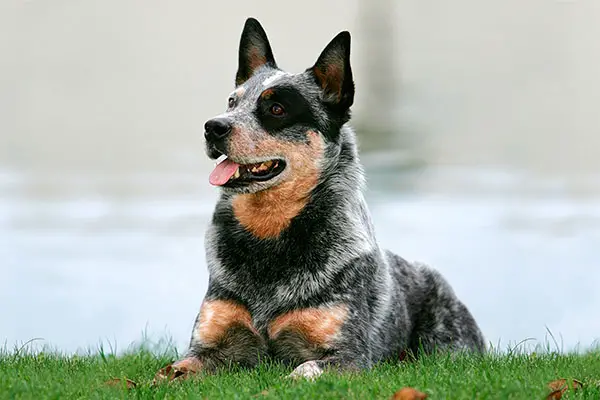
This breed is known for its intelligence, loyalty and independence, making it an ideal working breed.
It is responsive and eager to learn from structured training, however due to its herding instincts, it can be prone to nipping small children that are moving quickly.
The breed forms strong bonds with its owners and is protective of them and their belongings.
Grooming this breed is fairly easy as it only requires brushing during shedding season.
The main signs of health issues for this skilled herder are deafness and progressive blindness, both being hereditary conditions, as well as accidental injury – if lucky the Australian Cattle dog will have a lifespan of up to 16 years.
Characteristics
Appearance
The Australian Cattle Dog is a sturdy, muscular, and compact breed that gives the impression of strength and agility.
They have a broad skull that flattens to form a definite stop between the eyes with muscular cheeks and a medium-length muzzle.
The ears are pricked and small to medium sized set wide apart with a covering of hair on the inside.
The eyes are dark and oval shaped giving off an alert and keen expression.
Their neck and shoulders are strong and muscular; the forelegs are straight and parallel; the feet round arched, with small toes and nails.
According to the breed standard, they should be well muscled even when bred for companion or show purposes.
The Cattle Dog should be symmetrical in appearance with no parts exaggerated giving them neither vulnerable nor awkward look. This can limit their agility and endurance expected of a working dog.
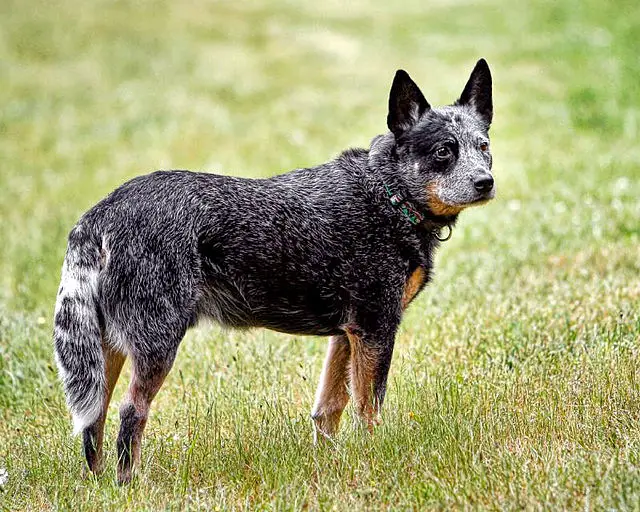
Size
The breed has a height of 43-51 cm (17-20 in) at the withers and typically weighs 18-25 kg (40-55 lb).
It has a longer body than it is tall with its height to length ratio usually 10:9.
Coat and color
Australian Cattle Dogs come in two coat colors: red and blue.
A blue Cattle Dog will have either a solid blue, mottled blue, or speckled blue with tan on the legs and chest – along with white markings and a black patch or “mask” on one or both sides of the head.
Red dogs are evenly speckled with red markings, which may include patches of solid or near-solid color such as “masks” over one or both eyes, white tip to tail, a solid spot at the base of the tail, and sometimes solid spots on the body.
They have a double coat of short guard hairs and dense undercoat that protect it from elements like water and wind.
It’s also recognized by its unique mask – one or both eyes may have black or red patches, either a single eye patch or double eye patch.
This breed may also be “plain-faced” without any patches.
Even markings of the mask are preferred over uneven markings in conformation shows.
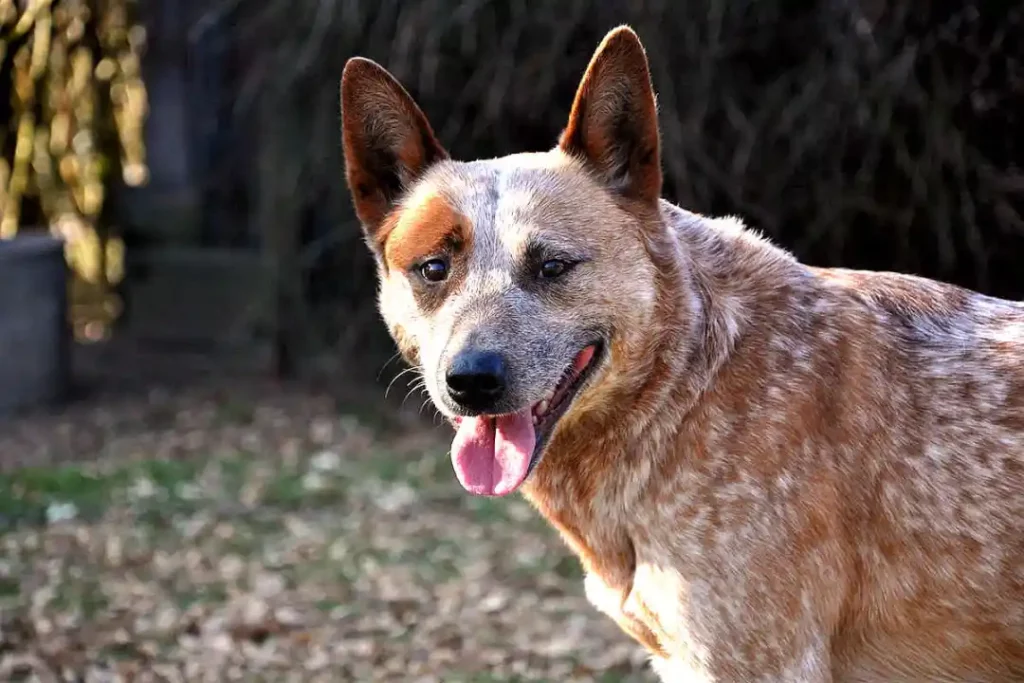
Tail
This breed has an undocked tail, being either solid in colour or with a white tip at the end.
The tail should sit moderately low and hang in a slight curve when the dog is at rest.
It may carry its tail higher up when it’s excited or playing.
In some countries like the US, tails on working stock dogs may be docked. However, this is not usually the case in Australia because of its important role towards increasing agility and manoeuvrability.
Though similar looking, the Stumpy Tail Cattle Dog is a separate breed which features a naturally “bobbed” tail; some of these can have natural thin long tails but most are born without one.
Temperament
Australian Cattle Dogs are known for their intelligence, bravery, and energetic nature.
They are generally very loyal and protective of their families and can develop strong bonds with their owners.
These dogs require regular activity in order to stay mentally stimulated and maintain a healthy physical condition.
They also need socialization from an early age in order to prevent anxiety-based behavior later in life.
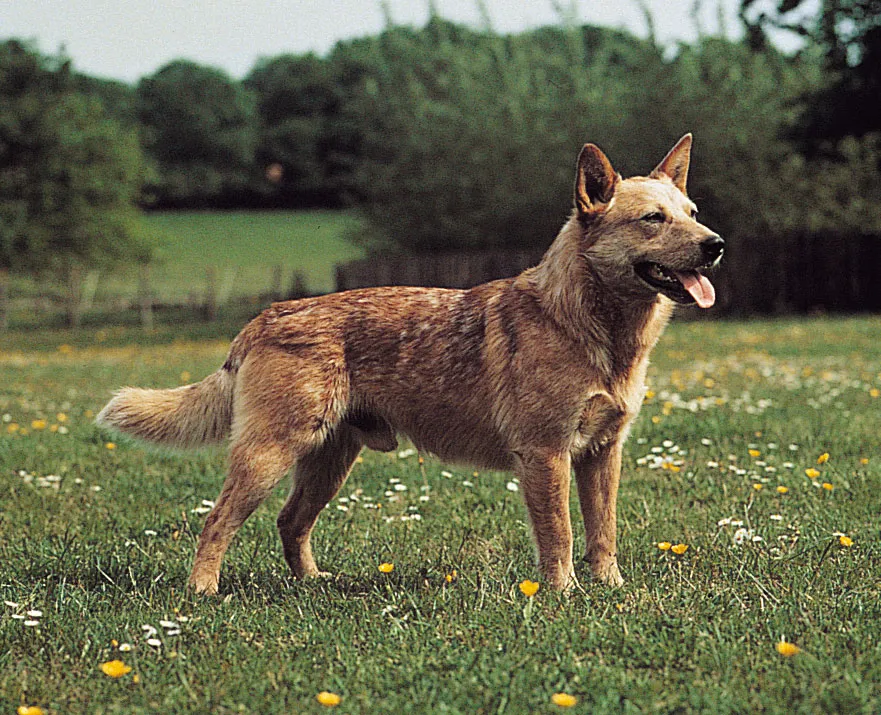
Owners’ Caring Expectations
Grooming
There’s no need for hours of grooming when it comes to the Australian Cattle Dog!
Their short coats require minimal upkeep, only needing occasional brushing and wiping down for show dog standards.
This breed sheds seasonally; a few extra brushings combined with a bath or two should control excessive hair during this time.
Don’t forget to keep up with regular hygiene care such as trimming nails, checking ears and teeth brushing too!
Training
As with all breeds of dogs, early training and socialization are important for Australian Cattle Dogs.
They are intelligent animals that have the ability to learn quickly. A firm but loving approach is essential.
Training should begin at an early age, ideally between 6 and 8 weeks old, and it should be consistent throughout their lifetime.
Consistency with commands, rewards for accomplishments, and positive reinforcement are the best ways to ensure your pup learns proper behavior.
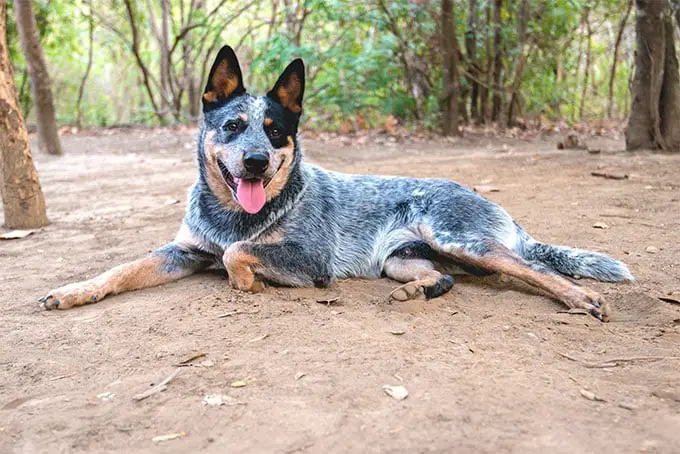
Activity Needs and Exercises
Australian Cattle Dogs have lots of energy and require plenty of exercise to stay healthy, both mentally and physically.
They need regular walks, playtime, and long hikes to burn off some of their excessive energy.
You should aim to provide at least 30-60 minutes of activity each day, whether it be a game of fetch in the backyard or a full-blown hike.
Obedience training is also recommended for these dogs as it helps them learn basic commands as well as become more obedient companions.
Nutrition
Given the level of activity this breed typically undertake day-to-day, it’s important to ensure that their diet consists of high-quality dog food.
This can either be commercially manufactured or prepared at home with the supervision and approval of a veterinarian.
It should also be tailored to suit their age—whether they’re a puppy, an adult, or an elderly canine.
From time to time, it’s perfectly acceptable to treat them with human food as long as you’re aware of which foods are safe for dogs and which ones aren’t.
Remember always to always leave fresh water for them too!
If you have any doubts or concerns about your Cattle Dog’s weight or diet, consult with your vet.
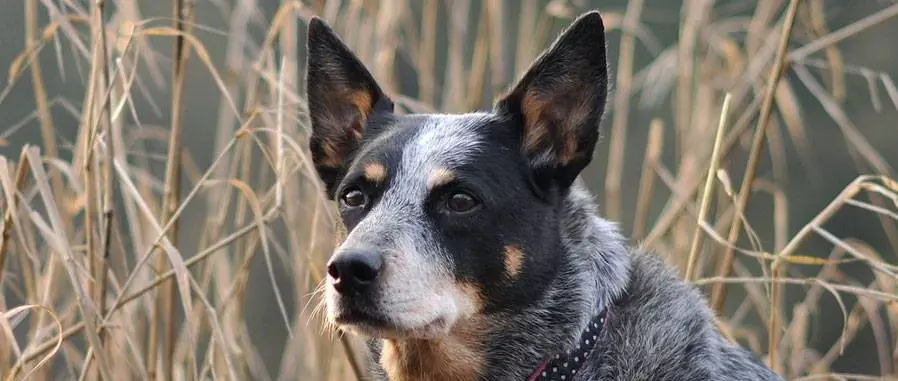
Health and lifespan
Lifespan
Australian Cattle Dogs are distinguished by their longevity, with a median lifespan of 11 to 13 years.
The breed generally ages well, with many dogs staying active until 12 or 14 years of age.
They can also maintain their sight, hearing and teeth into old age.
Interestingly, they appear to live nearly a year longer than other breeds of similar size.
Common health problems
As with any breed, it is important to consider the health of your Australian Cattle Dog.
They are generally considered healthy dogs, but some genetic conditions may be present, such as hip dysplasia, elbow dysplasia and eye diseases.
It is recommended that they receive regular veterinary check-ups to ensure they maintain good health.
Additionally, their nutrition should be monitored to make sure they have a balanced diet.
Exercise should also be included in your dog’s daily routine, as Australian Cattle Dogs require plenty of activity for physical and mental health.
History
The Australian Cattle Dog is an iconic herding breed that has been vital to the continent’s beef industry and the economy of Australia.
Although Smithfield dogs were originally used by stockmen, they were not adapted to the weather and terrain conditions in Australia.
As such, a deliberate breeding effort was undertaken to create a hardworking and durable herding dog that could handle the demands of working on cattle ranches in Australia.
This included crossing Smithfields with Dingoes, Scottish Highland Collies, Black and Tan Kelpie sheepdogs, and Dalmatians.
Ultimately, it was these diverse mixes which led to the development of the Australian Cattle Dog we know today;
The Australian Cattle Dog is a breed that has specific standards as set by the American, Canadian, and Australian kennel clubs.
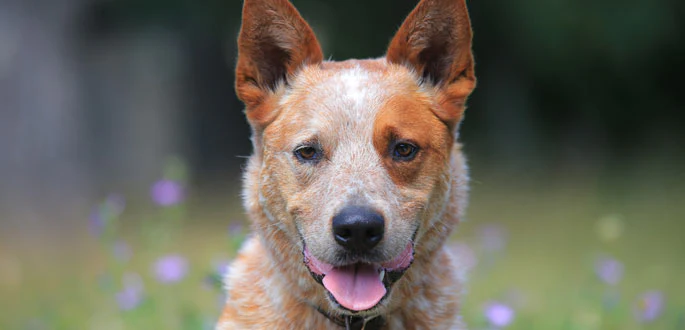
Frequently Asked Questions
Are Australian Cattle Dogs good pets?
Absolutely! Australian Cattle Dogs are active and loyal companions who thrive with plenty of exercise, long walks, and games.
They need lots of attention from their owners and get along well with children, other pets, and strangers.
With the proper amount of socialization and training, they can make great family pets.
What’s the difference between a blue heeler and an Australian Cattle Dog?
Both the blue heeler (or Australian cattle dog) and the red heeler (also known as Queensland heeler or Hall’s heeler) are breeds that descend from crosses of other types of herding dogs.
However, one major difference is that the blue has a blue or black coat, whereas the red is predominantly red in color.
Additionally, the blue heelers have a higher energy level, making them ideal for high-intensity activities such as jogging and agility training, whereas the reds have a milder temperament and may be better suited for those seeking a calmer companion.
Do Australian Cattle Dogs bark a lot?
While Australian Cattle Dogs are not known for being particularly vocal, they do tend to bark when there is a perceived threat or if they feel the need to protect their family or territory.
They will also bark to get attention and may bark out of boredom if not given enough exercise and mental stimulation on a regular basis.
Is an Australian Cattle Dog the same as a Dingo?
No, the Australian Cattle Dog is not the same as a Dingo. The two breeds have been bred for different reasons and possess very different features.
While dingoes were historically bred to survive in harsher climates and have less positivity towards humans, Cattle dogs are bred to herd cattle and have a reputation for being friendly and loyal companions.
How much is an Australian Cattle Dog puppy?
Australian Cattle Dogs can range in price from $300 to $3000, depending on its quality and pedigree.
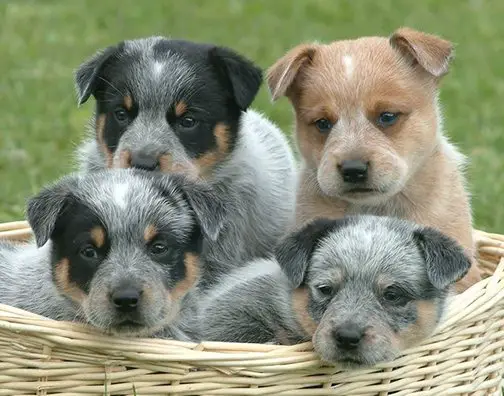
What problems do Australian cattle dogs have?
Australian Cattle Dogs are prone to certain hereditary health conditions such as hip and elbow dysplasia, eye diseases, deafness, atopy, and cerebellar ataxia.
Other issues that may affect them include stress-related behaviors, bloat, flea allergies and skin rashes.
Behavioral-related questions
Are Australian cattle dogs an aggressive breed?
Australian Cattle Dogs are generally not aggressive towards people, but they are known to be territorial and protective of their home and family.
They may be suspicious of strangers, and can have a strong prey drive which makes them good at herding livestock despite their small size.
It’s important to socialize Australian Cattle Dogs from an early age and provide them with consistent leadership and training in order to channel their energy in positive directions.
How do you calm an Australian cattle dog?
Australian Cattle dogs have a lot of energy and can be hard to calm down, but with the right techniques you can teach your dog to relax.
One way to do this is by teaching your dog basic obedience skills through positive reinforcement, such as sit-stay.
You can also give your dog plenty of exercise and mental stimulation, which will help them expend their energy in a constructive way.
Do Australian cattle dogs have anxiety?
Australian cattle dogs can experience periods of anxiety, which could manifest itself in behaviors such as barking, drooling, and restlessness.
The best way to manage this type of behavior is with consistency and positive reinforcement, including exercising them regularly and providing adequate time for training and socialization.
Red Australian Cattle Dogs
Is an Australian cattle dog a Red Heeler?
Yes, the Australian Cattle Dog is also known as a Red Heeler. The alternate name originates from the herding dog’s habit of nipping at the heels of animals to keep them in line.
Is a Red Heeler a good family dog?
Yes! They are an incredibly loyal and intelligent breed that make wonderful family pets.
They are highly active but crave human interaction and demand to be at the center of attention in their homes.
However, this demanding behavior may lead to stubbornness or separation anxiety if not properly trained.
But for many, these dogs become loving members of the family with gentle but strong personalities that add warmth to any household.
How much is a red Australian cattle dog?
The cost of adopting or buying a Red Australian Cattle Dog can range in price from $300 to $3000, depending on the age, gender, quality and geographical location.
What are red cattle dogs called?
The official breed name for red cattle dogs is the Australian Cattle Dog.
Blue Australian Cattle Dogs
Are blue cattle dogs good pets?
Yes, they make great pets, particularly if you have the time and energy to dedicate to them.
These dogs require plenty of daily exercise and training in order to channel their high energy levels.
However, with the right owner, they can be loving and loyal companions who will stick by you through thick and thin.
Are blue cattle dogs good with kids?
Yes, the Australian Cattle Dog is an excellent breed of dog for families with children.
Known as an intelligent breed, they enjoy learning tricks, playing outdoors, and spending time with their family.
They are loyal, protective and loving to their owners, making them great companions for younger children that need a furry friend.
Final Thoughts
The Australian Cattle Dog is a remarkable breed, known for its intelligence, endurance, and spirited demeanor. Perfect for active families and those interested in training for dog sports, this breed thrives when given a job to do.
Keep in mind that they require ample exercise, a balanced diet, and regular vet visits to ensure a healthy and fulfilling life. However, the time and energy invested in an Australian Cattle Dog are worth it as their loyalty and companionship are unmatched.
If you think this breed aligns with your lifestyle, an Australian Cattle Dog could be your next best friend.

